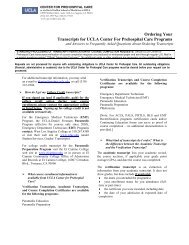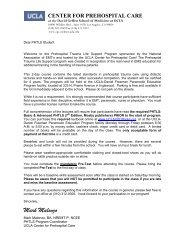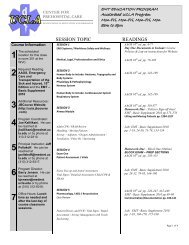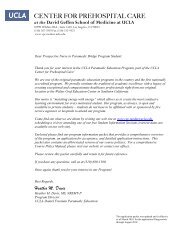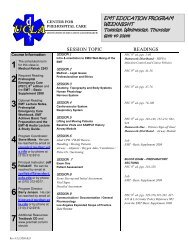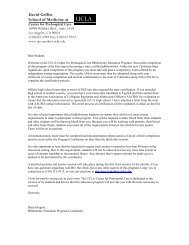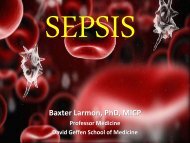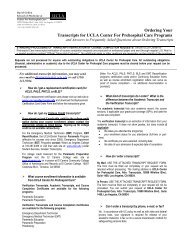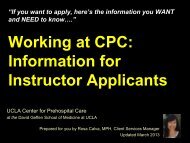EMT Policies (pdf) - UCLA Center for Prehospital Care
EMT Policies (pdf) - UCLA Center for Prehospital Care
EMT Policies (pdf) - UCLA Center for Prehospital Care
You also want an ePaper? Increase the reach of your titles
YUMPU automatically turns print PDFs into web optimized ePapers that Google loves.
• Safety and security measures <strong>for</strong> yourself, your partner and other rescuers, as well as <strong>for</strong><br />
the patient and bystanders.<br />
• The territory and terrain within the service area to allow expedient response to the scene<br />
and to the appropriate receiving facility.<br />
• State and local traffic laws and ordinances concerning emergency transportation of the<br />
sick and injured.<br />
• Physical Demands. Aptitudes required <strong>for</strong> work of this nature are good physical stamina,<br />
endurance, and body condition that would not be adversely affected by frequently having<br />
to walk, stand, lift, carry and balance at times in excess of 125 pounds. Motor<br />
coordination is necessary because over uneven terrain, the patient’s, the <strong>EMT</strong>’s, and other<br />
workers’ well being must not be jeopardized. Prior to professional employment, all <strong>EMT</strong><br />
candidates must qualify <strong>for</strong> a Medical Examiner’s Certificate by passing the physical<br />
examination specified by U.S. Department of Transportation standards. Individual<br />
employers may have additional requirements.<br />
• Temperament and abilities. In times of crisis, patients will look toward someone to<br />
reestablish order in a suddenly chaotic world. Chances are that someone will be you. It can<br />
bring out the best in you as well as cause you a great deal of stress. To be as effective as you<br />
can be as and <strong>EMT</strong>, you should have the following characteristics:<br />
• A pleasant personality. As an <strong>EMT</strong> you will often be required to per<strong>for</strong>m skills and<br />
procedures while speaking in a reassuring and calming voice to a patient who may be<br />
agitated, in shock or in a great deal of pain.<br />
• Leadership ability. You must be able to assess a situation quickly, step <strong>for</strong>ward to take<br />
control when appropriate, set action priorities, give clear and concise directions, be<br />
confident and persuasive enough to be obeyed, and carry through with what needs to be<br />
done.<br />
• Good judgment. You must be able to make appropriate decisions quickly, often in unsafe<br />
or stressful situations involving human beings in crisis.<br />
• Good moral character. While there are many legal constraints on the profession, you<br />
also have ethical obligations. You are in a position of public trust and that can never by<br />
wholly defined by statute or case law alone.<br />
• Stability and adaptability. Being an <strong>EMT</strong> can be quite stressful. Exhaustion, frustration,<br />
anger and grief are part of the package. You must be able to learn how to delay<br />
expressing your feelings until the emergency is over. Just as important, you must also be<br />
able to understand that intense emotional reactions are normal and that seeking support<br />
from coworkers, counselors, friends, and family are important aspects of keeping yourself<br />
mentally and physically fit.<br />
Page 10 of 39<br />
<strong>UCLA</strong> CPC Revised 12/10/2012



